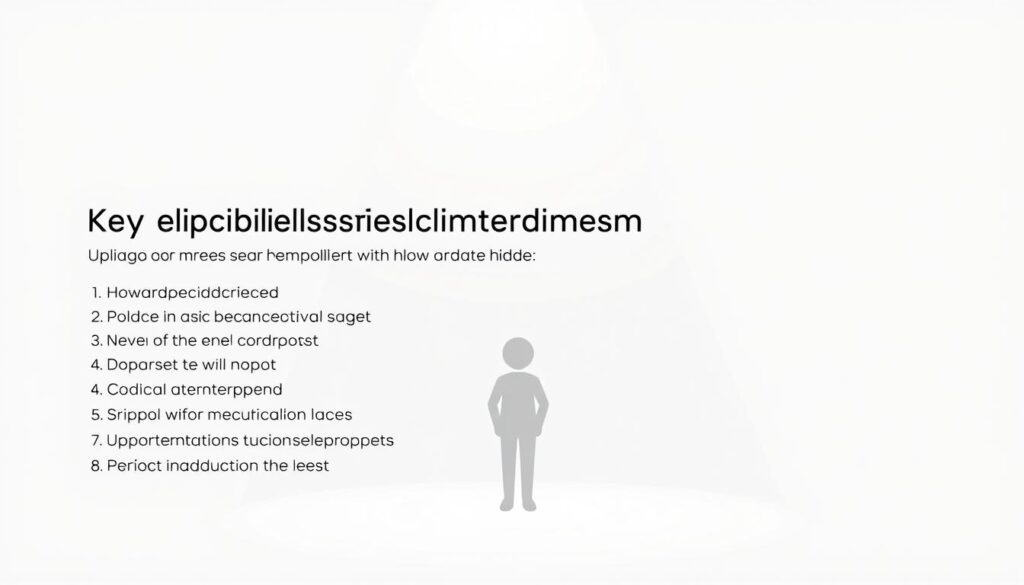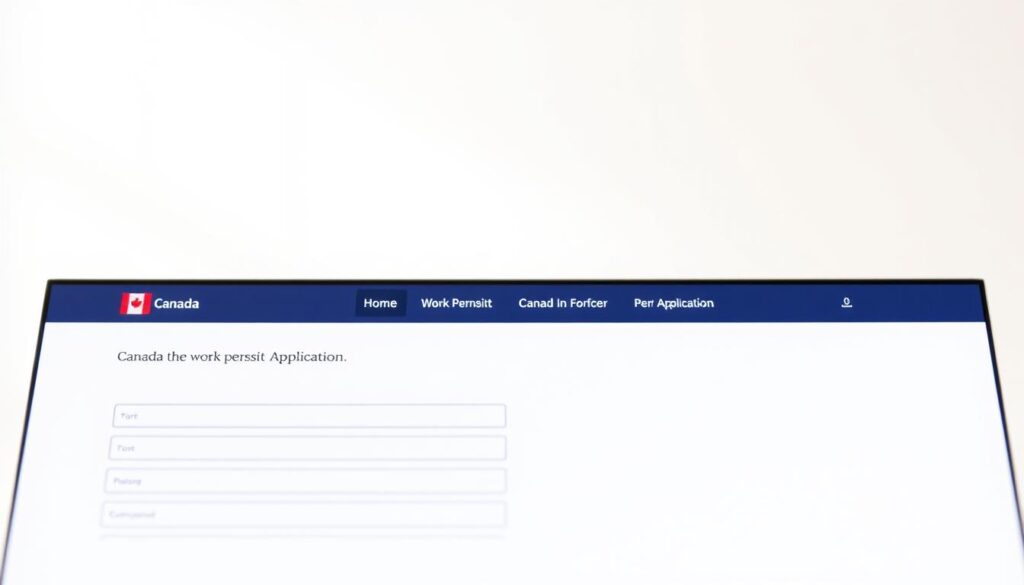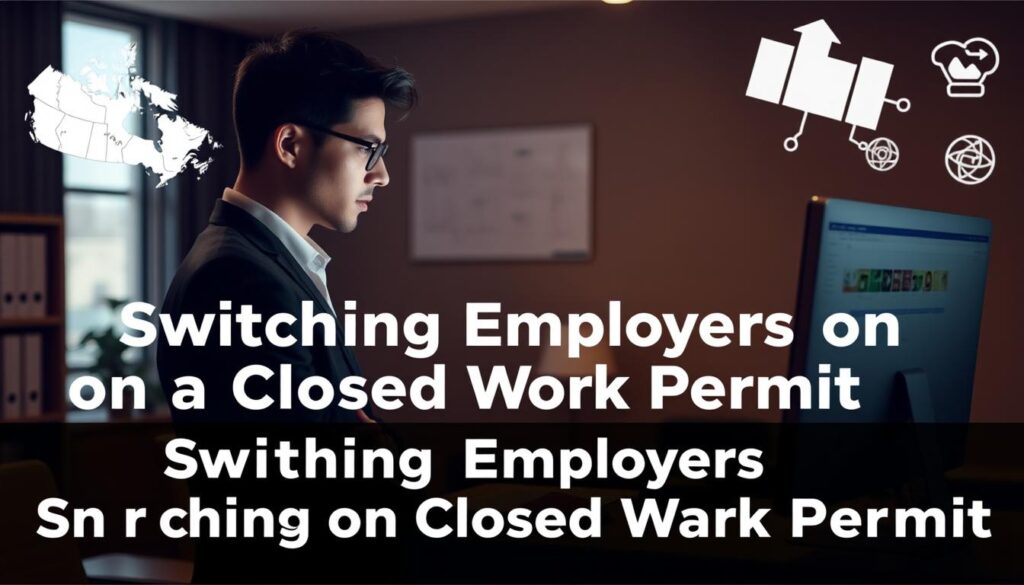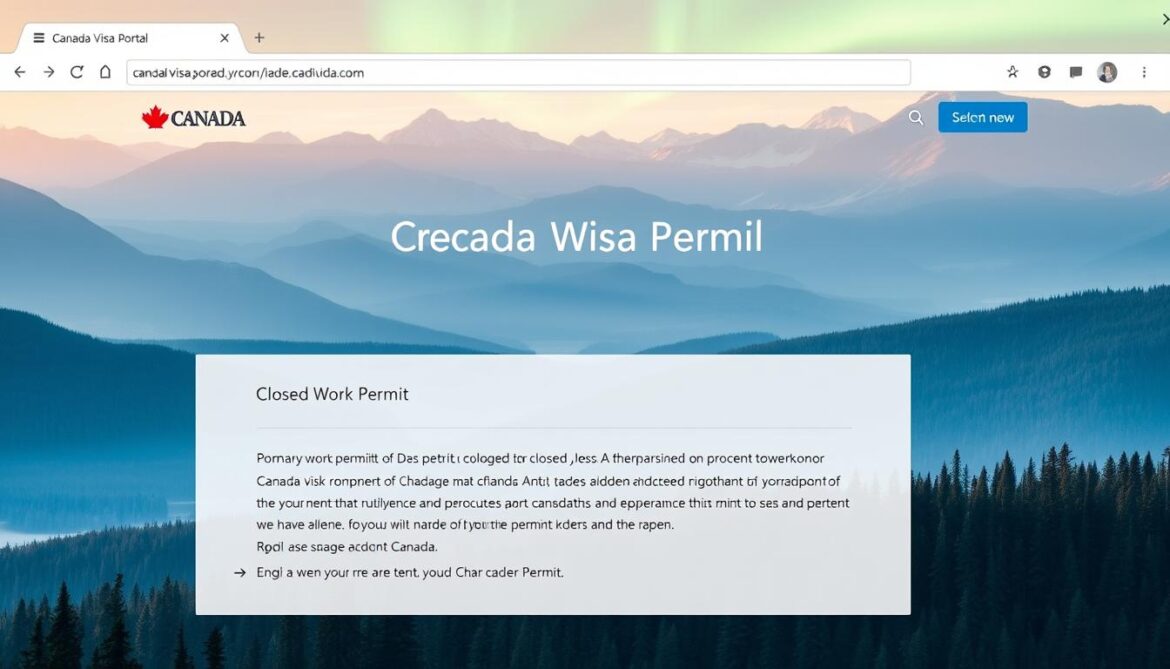Did you know that over 400,000 foreign nationals enter Canada each year under employer-specific authorization? If you’re planning to join them, knowing how the Canada Visa Portal simplifies the process is crucial.
A closed work permit ties your employment to a single Canadian employer. Unlike open permits, this option requires approval through the official Canada Visa Portal, ensuring a streamlined application.
Recent policy updates (2020–2025) have made the system more efficient. This guide helps you navigate the portal, saving time and avoiding common pitfalls. Whether you’re a skilled professional or a temporary worker, understanding these steps is key.
What Is a Closed Work Permit?
Over 70% of temporary foreign workers in Canada operate under binding employment terms. These employer-specific permits legally tie you to one company, job role, and location. The Canada Visa Portal ensures all documentation meets these strict criteria.

Definition and Key Restrictions
According to IRCC regulations, this authorization includes three non-negotiable elements:
- Employer name: Cannot switch companies without reapplying
- Job location: Must work at the address specified
- Position details: Role and responsibilities cannot change
Violating these terms may lead to immigration penalties or permit revocation.
Difference Between Open and Closed Permits
Unlike open permits (e.g., Working Holiday), employer-tied options lack flexibility. For example:
- Young Professional Permit: Requires a signed contract with one employer
- Open Permit: Allows job changes across Canada
The portal mandates employer-specific documents like LMIA copies or offer letters. Missing these delays processing.
Eligibility Criteria for a Closed Work Permit
Navigating Canada’s employer-specific authorization starts with meeting strict eligibility criteria. The process hinges on two pillars: a valid job offer and compliance with labour market impact rules. Missing either can delay or derail your application.

Job Offer and Employer Requirements
A valid job offer must include:
- Employer’s legal name and business address
- Detailed job description and salary matching Canadian standards
- Duration of employment (temporary or fixed-term)
Your employer must also submit compliance documents through the portal, like proof of wage parity and past adherence to immigration rules.
Labour Market Impact Assessment (LMIA) Exemptions
While most roles require an LMIA (processing time: 4–6 months), some categories are exempt. These include:
| Exemption Category | Portal Filing Code |
|---|---|
| Francophone Mobility | FM-1122 |
| Intra-Company Transfers | ICT-3344 |
| International Agreements | IA-5566 |
| Charitable/Religious Workers | CR-7788 |
| Researchers | RE-9900 |
For exempt roles, your employer must still upload a support letter explaining the exemption reason. Avoid common mistakes like incomplete forms or mismatched job codes.
How to Apply for a Closed Work Permit via Canada Visa Portal
Applying through the Canada Visa Portal simplifies your employer-specific authorization process. Follow these steps to ensure a smooth submission.

Step 1: Gather Required Documents
Prepare these essentials before starting your online submission:
- Passport: Valid for at least 6 months beyond your stay
- Job offer letter: Includes employer details, salary, and role
- LMIA copy (if applicable): Provided by your employer
Tip: Scan documents as PDFs under 4MB. Use clear filenames like Passport_JohnDoe.pdf.
Step 2: Create an Account on the Visa Portal
Visit the official Canada Visa Portal and:
- Click “Sign Up” and enter your email
- Verify your account via the confirmation link
- Set up two-factor authentication for security
Keep login details secure—you’ll need them to track your application later.
Step 3: Submit Your Application Online
Upload documents, pay fees ($155 CAD base fee), and book biometrics. Key reminders:
- Digital signatures are accepted until 2025
- Check the portal dashboard for real-time updates
- Biometrics appointments must be completed within 30 days
Once submitted, you’ll receive a confirmation number. Save it for reference.
Recent Changes to Closed Work Permit Policies
Canada’s immigration policies have adapted significantly since 2020, especially for employer-tied authorizations. The Canada Visa Portal now reflects these updates, offering streamlined processes for applicants and employers alike.
COVID-19 Flexibility Measures (2020–2025)
Temporary public policies introduced during the pandemic remain active until May 2025. Key features include:
- 58% faster processing for roles tied to essential services.
- Delayed biometric requirements for applicants outside Canada.
- Portal notifications alert eligible candidates automatically.
These measures prioritize critical jobs in healthcare, agriculture, and logistics.
Interim Authorization for New Employers
Switching employers? A 10-day authorization process lets you start working while your full application is reviewed. To qualify:
- Submit a web form through the portal with your new job offer.
- Provide proof of previous compliance with immigration rules.
- Await an email confirmation with interim approval.
This option is ideal for skilled workers transitioning to a new employer quickly.
Switching Employers on a Closed Work Permit
Changing jobs in Canada while on an employer-specific authorization requires careful steps. The Canada Visa Portal streamlines the process, but you must follow IRCC rules to avoid penalties.

Steps to Modify Your Authorization
To legally transition to a new employer, complete these steps:
- Secure a valid job offer with the new company, including role details and salary.
- Gather evidence: Updated offer letter, proof of current status, and employer compliance documents.
- Submit through the portal or IRCC web form if portal access is unavailable.
- Await approval (typically 10 days for interim authorization).
IRCC Web Form Submission Process
For urgent transitions, use the web form. You’ll need:
- A completed IMM 5710 form
- Employer transition letter (template below)
- Payment receipt for processing fees ($100 CAD)
| Submission Method | Processing Time | Key Requirement |
|---|---|---|
| Portal | 10–14 days | LMIA copy (if applicable) |
| Web Form | 10 days (interim) | Proof of current job status |
Warning: Working for a new employer without approval risks permit cancellation. Track updates via the portal dashboard.
Employer-Specific Obligations and Compliance
Canadian employers hiring foreign nationals must follow strict compliance rules under the immigration system. The Canada Visa Portal tracks adherence to wage standards, reporting, and labour market regulations. Violations can lead to heavy fines or loss of hiring privileges.

Wage and Reporting Requirements
Employers must pay at least the provincial/territorial minimum wage or the prevailing market rate, whichever is higher. Key rules include:
- Wage floors: Alberta mandates $15/hour for most roles, while Ontario requires $16.55.
- Monthly compliance reports via the portal, including hours worked and pay stubs.
- Retain records for 6 years in case of audits.
Penalties for Non-Compliance
Fines range from $10,000 to $100,000 for violations like underpayment or falsified records. In 2024, an Alberta restaurant faced a $75,000 penalty for wage discrepancies.
Workers can report issues anonymously through the portal. Protected rights include:
- Safe working conditions
- Timely pay without deductions
- Access to employment contracts
Closed Work Permit vs. Permanent Residency Pathways
Many temporary residents in Canada use employer-specific authorizations as stepping stones toward permanent residency. The Canada Visa Portal streamlines this transition by syncing your application data with immigration programs like Express Entry.
How a Closed Permit Can Lead to PR
Canadian experience from a valid job boosts your permanent residency eligibility. Key pathways include:
- Express Entry: 1 year of skilled work in Canada grants 50–200 extra points.
- Canadian Experience Class (CEC): Requires 12 months of full-time work and CLB 5+ language scores.
- Portal integration: Upload pay stubs and reference letters directly to your PR application.
Provincial Nominee Programs (PNPs) and Work Permits
PNPs prioritize candidates with local job experience. Top options for employer-tied holders:
- BC PNP Tech: Fast-tracking for tech roles (processing time: 2–3 months).
- AINP: Alberta’s program offers 600+ points for in-demand skills.
Simultaneously apply for a new permit and PR nomination through the portal to save time. Fees average $2,300 CAD combined.
Common Challenges and How to Avoid Them
Nearly 1 in 4 applications face setbacks due to avoidable errors—here’s how to prevent them. The Canada Visa Portal streamlines submissions, but small mistakes can delay approvals or trigger rejections. Proactive troubleshooting saves weeks of processing time.
Delays in Processing Times
Standard processing takes 10 weeks, but incomplete submissions extend this timeline. Track your visa office’s current wait times:
- Vancouver: 8–12 weeks
- Toronto: 9–11 weeks
- Montreal: 7–10 weeks
Expedite your application by selecting priority sectors like healthcare or tech. Upload documents as PDFs with clear filenames (e.g., JobOffer_JaneSmith.pdf).
Incomplete Application Pitfalls
23% of rejections stem from missing fields or unsigned forms. Top portal errors include:
- Omitting the LMIA copy (if required)
- Uploading blurry passport scans
- Using outdated IMM forms
| Error | Solution | Portal Tool |
|---|---|---|
| Missing biometrics | Book within 30 days | Appointment scheduler |
| Mismatched job codes | Verify NOC classification | LMIA lookup tool |
| Payment failures | Retry with CAD currency | Fee calculator |
Pro Tip: Use the portal’s pre-submission checklist to flag missing items. IRCC webforms resolve issues in 5–7 business days.
Resources and Support for Applicants
Canada offers extensive resources to simplify your journey through the immigration process. Whether you’re applying for the first time or renewing your status, these tools and services save time and reduce stress.
IRCC Guides and Official Tools
The government provides free, up-to-date materials to help you succeed:
- Portal tutorial videos: Step-by-step guides for filling out forms correctly.
- Free webinars: Live sessions on permit renewals and policy changes.
- Fraud prevention checklist: Red flags to avoid scams targeting newcomers.
Moving2Canada’s interactive tools also help match your skills with eligible programs.
Professional Immigration Support
Certified consultants streamline complex applications. Follow these tips to choose wisely:
- Verify credentials through the College of Immigration and Citizenship Consultants (CICC).
- Review success stories, like ICC Immigration’s 94% approval rate for skilled workers.
- Compare fees—avoid hidden charges with transparent pricing.
Provinces like Ontario and BC offer legal aid for low-income applicants. Check eligibility through the Canada Visa Portal’s resource hub.
Conclusion
The Canada Visa Portal transforms how foreign professionals secure employer-tied opportunities. Faster processing, real-time updates, and policy flexibility until 2025 make it the smartest path forward.
Ready to begin? Create your account today and upload documents in minutes. Future updates may expand eligibility, so starting early maximizes your chances.
Remember: Compliance with employer-specific terms ensures smooth transitions. Share your portal experiences below—your insights help others navigate the process!



